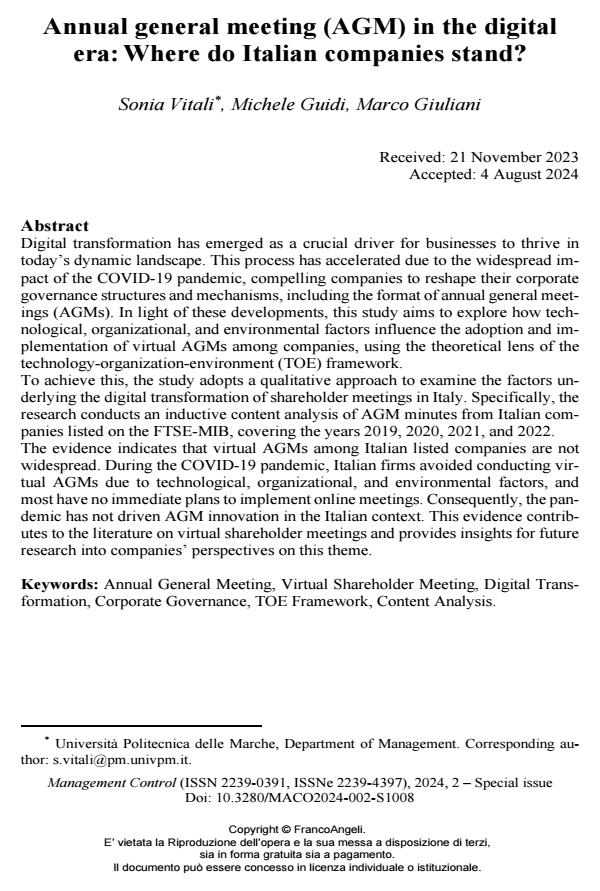Annual general meeting (AGM) in the digital era: Where do Italian companies stand?
Journal title MANAGEMENT CONTROL
Author/s Sonia Vitali, Michele Guidi, Marco Giuliani
Publishing Year 2024 Issue 2024/2 Suppl.
Language English Pages 23 P. 149-171 File size 421 KB
DOI 10.3280/MACO2024-002-S1008
DOI is like a bar code for intellectual property: to have more infomation
click here

FrancoAngeli is member of Publishers International Linking Association, Inc (PILA), a not-for-profit association which run the CrossRef service enabling links to and from online scholarly content.
Digital transformation has emerged as a crucial driver for businesses to thrive in today’s dynamic landscape. This process has accelerated due to the widespread impact of the COVID-19 pandemic, compelling companies to reshape their corpo-rate governance structures and mechanisms, including the format of annual gen-eral meetings (AGMs). In light of these developments, this study aims to explore how technological, organizational, and environmental factors influence the adop-tion and implementation of virtual AGMs among companies, using the theoretical lens of the technology-organization-environment (TOE) framework. To achieve this, the study adopts a qualitative approach to examine the factors underlying the digital transformation of shareholder meetings in Italy. Specifically, the research conducts an inductive content analysis of AGM minutes from Italian companies listed on the FTSE-MIB, covering the years 2019, 2020, 2021, and 2022. The evidence indicates that virtual AGMs among Italian listed companies are not widespread. During the COVID-19 pandemic, Italian firms avoided conducting virtual AGMs due to technological, organizational, and environmental factors, and most have no immediate plans to implement online meetings. Consequently, the pandemic has not driven AGM innovation in the Italian context. This evidence contributes to the literature on virtual shareholder meetings and provides insights for future research into companies’ perspectives on this theme.
Keywords: Annual General Meeting, Virtual Shareholder Meeting, Digital Trans-formation, Corporate Governance, TOE Framework, Content Analysis.
Sonia Vitali, Michele Guidi, Marco Giuliani, Annual general meeting (AGM) in the digital era: Where do Italian companies stand? in "MANAGEMENT CONTROL" 2 Suppl./2024, pp 149-171, DOI: 10.3280/MACO2024-002-S1008